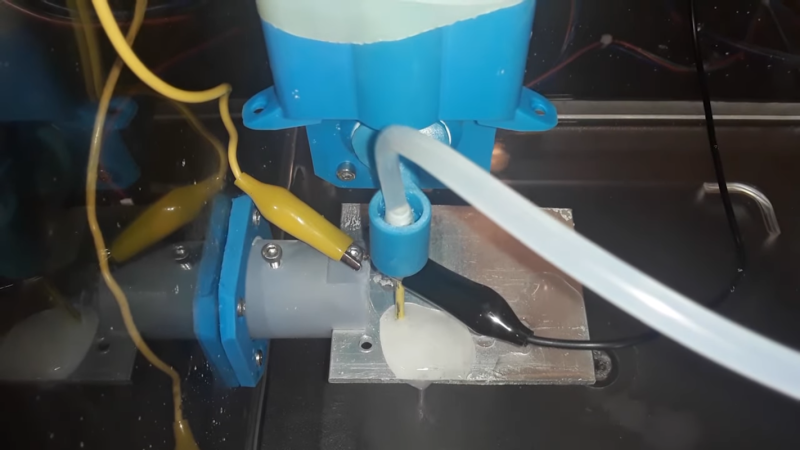Every now and then we’ll see a 3D printer that can print an entire house out of concrete or print an entire rocket out of metal. But usually, for our budget-friendly hobbyist needs, most of our 3D printers will be printing small plastic parts. If you have patience and a little bit of salt water, though, take a look at this 3D printer which has been modified to cut parts out of any type of metal, built by [Morlock] who has turned a printer into a 5-axis CNC machine.
Of course, this modification isn’t 3D printing metal. It convers a 3D printer’s CNC capabilities to turn it into a machining tool that uses electrochemical machining (ECM). This process removes metal from a work piece by passing an electrode over the metal in the presence of salt water to corrode the metal away rapidly. This is a remarkably precise way to cut metal without needing expensive or heavy machining tools which uses parts that can easily be 3D printed or are otherwise easy to obtain. By using the 3D printer axes and modifying the print bed to be saltwater-resistant, metal parts of up to 3 mm can be cut, regardless of the type of metal used. [Morlock] also added two extra axes to the cutting tool, allowing it to make cuts in the metal at odd angles.
Using a 3D printer to perform CNC machining like this is an excellent way to get the performance of a machine tool without needing to incur the expense of one. Of course, it takes some significant modification of a 3D printer but it doesn’t need the strength and ridigity that you would otherwise need for a standard CNC machine in order to get parts out of it with acceptable tolerances. If you’re interested in bootstraping one like that using more traditional means, though, we recently featured a CNC machine that can be made from common materials and put together for a minimum of cost.
Thanks to [Zane] for the tip!
















I wonder how much work it would be to get to sub 50um accuracy and precision.
It’s more like a 3D subtracter then a 3D printer…
convers a 3D printer’s: convert?
Really fascinating concept, thanks for posting!
The ECM approach to working with metal has a lot of potential. It removes the noise weight and rigidity aspect needed for working accurately with any kind of rotating cutter. It also has some advantages over a cnc plasma and lasers. I guess the big disadvantage is speed and work envelope but for small intricate jobs it works well. It’s hard to think of anything else that can sit on your desktop that has this capability. It would be nice to see someone design a really stripped down streamlined version. I would be happy with a 3 axis.
Yeah I’m also fine with 3 axis. It would simply tool path generation. Focus on reliable tool speed / cut width.
I’m very excited to watch this to evolve. You can make arbitrarily shaped cutting tools with the 3d printer and then metal coat them. The cutting process is slow but still very useful and can even handle hardened steel.
Can’t wait for the first ECM machined are receiver
*AR
AR … Okay, that makes sense. Should be interesting.
can’t wait for the first ecm machined engine block.
I’ve spent some time working on engine head castings. The issue is the internal water and oil passages, which any subtractive process struggles with. People have done this by milling the insides and then welding side plates on, and (as traditional manufacturing) drilling in oil passages.
Although there’s not a lot of challenge to engine blocks. Turbine blades, now…
Sewing machine, stand mixer, y’know mechanical stuff you can’t really buy off the shelf anymore cause every box store brand sells out and fills the insides with plastic cogs as soon as you hear about them.
It’s really too bad this can’t scale well. That Faraday Constant is a real headache.
But, hey, people still make aluminum and glass, so maybe extraordinary energy input and copious effluent per unit output mass isn’t really that hard to cope with — just bake it into the product cost, and damn the environment.
really? wow. is that like DMM (Destructive Marble Modeling) Sculpting or the fact you no NOTHING about machining OR making anything.
Next you will tell us how mud was the most important invention and that writing was meaningless. I mean history and math is racist.
Very insightful and helpful comment.
And such a cute and clever username! I’ll guess you are very popular at parties.
There is a similar/related technology called EDM that is significantly faster and still has low tool forces that could still be handled by plastic tooling. It’s still not as fast as conventional machining, but might be worth a look.
It is NOT faster. Quite contrary. ECM is much much faster than EDM.
I must hate been mistaken. Thanks!